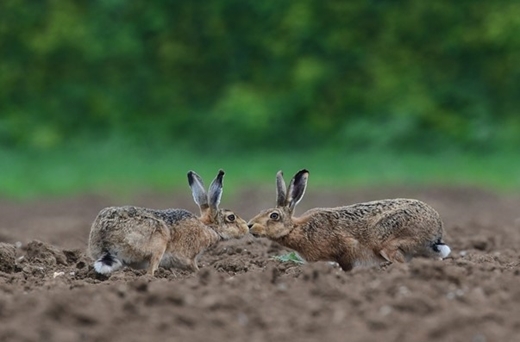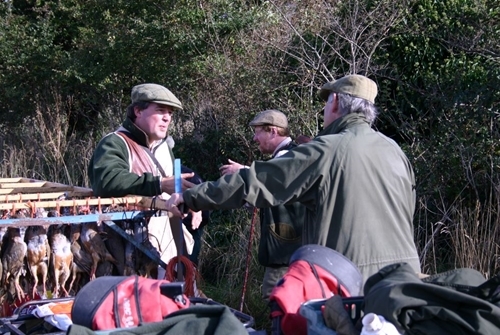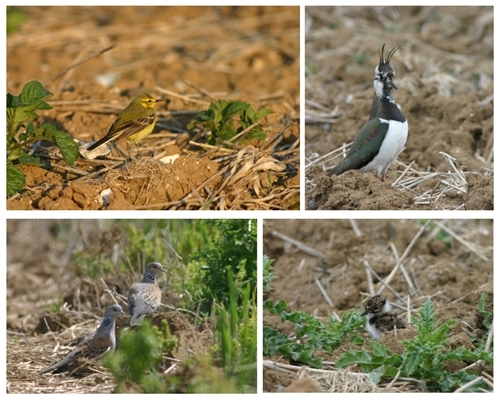 A couple of Nether Hale hares getting ready to box. Credit: Russell Miles
A couple of Nether Hale hares getting ready to box. Credit: Russell Miles
By Mike Swan, GWCT Senior Advisor
If you are an older GWCT member, that title might just ring bells; it was already a long-term slogan of what was then The Game Conservancy Trust’s advisory service when I joined the team in 1982. It is also fair to say that it embodies what the organisation was about dating right back to its formation in the 1930s as ICI game research and the Eley Game Advisory Service.
Throughout our history, a main thread of what GWCT is about has been making sure that the results of our rigorous scientific research get through to land managers of all kinds, so that they can act on them. In the beginning the motivation for this was apparently quite simple, as the effective monopoly holder in shotgun cartridge manufacture, anything that ICI/Eley could do to improve game populations was calculated to increase sales.
Today, it is a bit more subtle; the link with conservation is much stronger now, so the advice we offer is about improved game management and the link to better conservation, following the more recent GWCT slogan of Conservation Through Wise Use. However, the GWCT advisory team are still very much there to help members with shoot management issues, whatever they may be.
Case Study: Nether Hale
Over my 40 plus years as a GWCT adviser, I have provided one to one on site advice to hundreds of shoots, from little DIY syndicates and small farm shoots, to great and historic estates. One of my proudest moments was when my friends and clients Ian and Claire Smith, of Nether Hale in Kent won the Purdey Awards for Game and Conservation, back in 2003. But my story with the Smiths goes back a decade further, and in the beginning it was all about the shoot, and how to bump up the returns on their redleg release.
Nether Hale is on Thanet, that lump of NE Kent which sticks out into the North Sea, and which was once separated from the mainland by saltmarsh and the Wantsum Channel. Lying partly below sea level, Nether Hale can be a cold and bleak place at times, but in common with the rest of Thanet, is relatively frost free and has deep silty soils with lime rich groundwaters seeping in from the chalk. All this makes it great vegetable growing country, with cauliflowers a particular speciality.
Those cauliflowers were both a great asset and a big part of the problem at Nether Hale. With three quarters of its 350 acres devoted to them at any one time, there was no shortage of sheltered habitat for the redlegs, but they provided what amounted to a sea of cover to hide in, making finding them on a shoot day very hard, and getting them over the Guns even harder.
 Redlegs are the main quarry at Nether Hale.
Redlegs are the main quarry at Nether Hale.
Rather to my amusement, Ian had put in two patches of kale for the game, nurturing them to perfection using all his skills as a brassica grower. It was not until I asked him how the redlegs were supposed to tell the difference as to whether they were hiding under kale and or caulis that Ian realised his choice of crop was not best suited to his situation.
Normally, I would choose kale over almost anything; it offers great cover, with wonderful extra value to a diverse range of farmland wildlife, but in this case I felt we needed something dry and different, to stand out more strongly from the caulis. So, I suggested that replacing it with maize would be a good idea.
What I also spotted was that Ian had what amounted to two stand-alone drives from his two cover plots, so I suggested a third one alongside a nice driving hedge, to link the other two, and make a network of drives that would feed one another during the shoot day. There was much sucking of teeth over this, with Ian the farmer muttering “But that is some of my best cauliflower ground”. Fortunately, Claire’s dad, Tim Long, and family friend and all round shooting guru Wilf Harris, straightened him out over this a few days later, so my extra strip went in.
With the dry cover theme still in mind, I also persuaded Ian that a small setaside field called First Horse Marsh should be turned from grass to a wild bird seed mix with the likes of millet, quinoa and linseed. This patch is situated in the middle of the farm, between the three main drives, and made a lovely central focus that provided extra autumn cover and food for the game and much other wildlife.
All this, and perhaps a bit of renewed enthusiasm produced a much improved result come the autumn, and the Nether Hale shoot went from strength to strength, with records tumbling time and again over the next few years. I still count myself very lucky to have been there to share in some of those shoot days, and it was a privilege to write up Ian and Claire’s success for Shooting Gazette, although I did get a roasting for not mentioning the beaters. They sent me a petition about respect for them, in which they threatened to ensure that nothing would fly over my peg if I was lucky enough to be invited again….
Adapting for conservation
Great shoots evolve, and Nether Hale is no exception. In 1999 Ian decided to give up the cauliflowers in favour of a mix of arable cropping and countryside stewardship. This change coincided with the wild grey partridges reaching a low point of just three pairs, in the spring of 2000, prompting a decision to try to recover the population, using the change in farming and the potential of countryside stewardship to improve habitat for them. With help and guidance from my colleague Peter Thompson, then GWCT farmland conservation adviser, and Dan Tucson from Natural England, Ian put together a stewardship proposal designed to help the greys, at the same time building on the game crops with wild bird seed mixes, now including some kale, which further improved the shoot.
Alongside this Ian stepped up the predation control programme, to help the greys flourish. As he recently reminded me, this included hiring my services for a one-to-one tutorial on using humane cable restraints to catch foxes. The results were spectacular, with the pair count rising to fifty-five in 2006, allowing the no greys to be shot rule to waived.
 Farmland birds did well at Nether Hale; turtle dove, lapwing and chick, and yellow wagtail. Credit: Ian Smith.
Farmland birds did well at Nether Hale; turtle dove, lapwing and chick, and yellow wagtail. Credit: Ian Smith.
But this was only part of the story; with the help of two local birdwatchers and BTO members called Ken and Dave, Ian was able to document a dramatic recovery of a suite of farmland birds, from corn buntings and skylarks to lapwings and turtle doves. Birds were not the only beneficiaries by a long way. Hares, for example, responded in leaps and bounds, and it’s a certainty that small mammals like mice, voles and shrews benefitted too.
At the same time, Ian and Claire took the decision to use Countryside Stewardship to revert their lowest lying land to wet pasture, complete with scrapes. This resulted in a dramatic increase in the wildfowl wintering at Nether Hale, adding another exciting element to the shoot.
All this combined to make them worthy Purdey winners, but the shooting was still key. Releasing redlegs was still essential to what Ian and Claire were after. Meanwhile, wild pheasants flourished too, benefitting from the combination of habitat improvement and predation control, and adding further variety on shoot days.
Sadly, the dizzy heights of 2006 were impossible to maintain, at least in terms of grey partridges, with predation pressure undoubtedly going up. It was at about this time that marsh harriers established themselves in that part of North Kent, and an enormous new glasshouse development alongside provided perfect lookout posts for an enhanced population of peregrines. If you add increases in sparrowhawk, buzzard and wintering hen harriers, you can see that there is bound to be some impact on the wild partridges.
But, the greys are still there, if no longer at a level to allow a shootable surplus. These days Ian and Claire’s son, Tim who invited me to shoot back in January, is very much involved in the running too. It was a joy to see that the drives which were developed back in the 1990s were still there, and still working, with redlegs fizzing over the hedges in the old-fashioned way.
A modest mixed bag of redlegs, pheasants, pigeons, teal, snipe and even a crow made for a very happy day for all present. The strong conservation ethic remains too, with lots of great farmland wildlife habitat still in place, and the wet pastures growing ever more diverse. Long may it continue.
How the GWCT can help you
No two shoots are the same and the GWCT remains firmly of the view that the best way to help individual shoots is through one-to-one advice on the ground concerned. This means that suggestions for improvement can be tailored to the exact needs of the site, and the aspirations of the people involved. You can find out more about our advisory service here. To book a visit from your local adviser please email Lizzie Herring at lherring@gwct.org.uk.